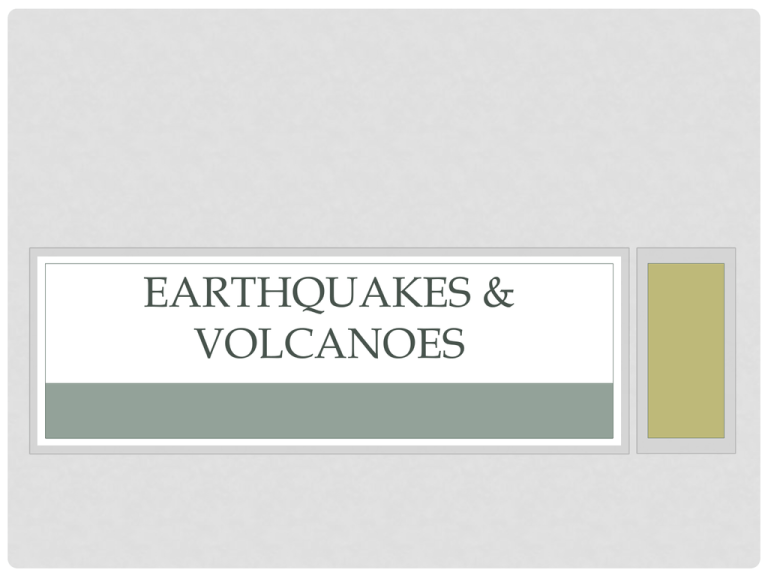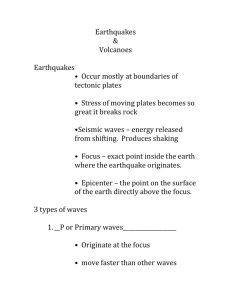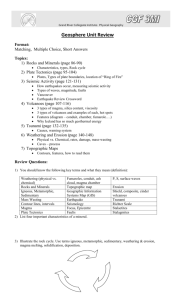File earthquakes & volcanoes pwpt
advertisement

EARTHQUAKES & VOLCANOES EARTHQUAKES • Vibrations in the ground that result from movement along breaks in Earth’s lithosphere called faults WHERE DO EARTHQUAKES OCCUR? • Most earthquakes occur along plate boundaries TYPES OF FAULTS • Normal • forces pull two blocks of rock apart • ex. divergent plate boundary • Reverse • forces push two blocks of rock together • ex. convergent plate boundary • Strike-Slip • two blocks of rock slide horizontally past each other • ex. transform plate boundary EARTHQUAKE EPICENTER • Seismic Waves - Energy that travels as vibrations on and in the Earth • Focus – where seismic waves originate and where rocks first move along the fault • Epicenter - location on the Earth’s surface where the seismic waves originated TYPES OF SEISMIC WAVES • Primary (P) Waves • move in a push-pull motion like a spring • fastest-moving waves and the first waves you feel • Secondary (S) Waves • move in an up-and-down motion • slower than P waves • do not travel through liquid • Surface Waves • travel only on Earth’s surface in a rolling motion • most destructive STUDYING EARTHQUAKES • Seismologist – scientist that studies earthquakes • Seismometer – instrument used to measure and record ground motion • Earthquake Scales: Richter Scale measures ground motion Moment Magnitude Scale measures total amount of energy released by an earthquake Modified Mercalli Scale measures and describes damage resulting from an earthquake VOLCANOES • A vent in Earth’s crust through which molten rock (magma) flows • Once magma reaches the surface it is called lava FORMATION OF VOLCANOES • Most volcanoes form at plate boundaries • Convergent • as one plate subducts beneath another the rock melts and rises to the surface • Divergent • As the plates separate magma rises through the vent in Earth’s crust and forms new crust • ex. sea-floor spreading HOT SPOTS • Volcanoes not associated with plate boundaries • convection currents in the mantle rise magma to the surface • as plates move over the hot spot island chains are formed • The oldest island is the farthest away from the hot spot • ex. Hawaiian Islands TYPES OF VOLCANOES • Shield Volcano • large, with gentle slopes • form along divergent boundaries or hot spots • Composite Volcano • large and steep-sided resulting from explosive eruptions • form along convergent boundaries • Cinder Cone • Small, steep-sided VOLCANIC ERUPTIONS • Quiet Eruptions • magma has a low viscosity (low silica content) • Violent Eruptions • magma has a high viscosity (high silica content) EFFECTS OF VOLCANIC ERUPTIONS • Pyroclastic Flow • fast-moving avalanches of hot gas, ash, and rock that can reach speeds of up to 100 km/h and temperatures of up to 1000 °C • Lava Flows • Ash Fall • Mudflows









